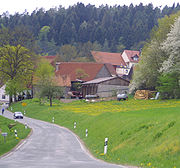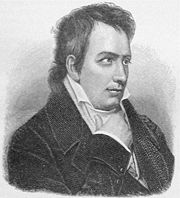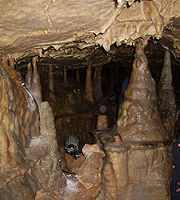
Franconian Switzerland
Encyclopedia


Upper Franconia
Upper Franconia is a Regierungsbezirk of the state of Bavaria, southern Germany. It forms part of the historically significant region of Franconia , all now part of the German Federal State of Bayern .With more than 200 independent breweries which brew...
, northern Bavaria
Bavaria
Bavaria, formally the Free State of Bavaria is a state of Germany, located in the southeast of Germany. With an area of , it is the largest state by area, forming almost 20% of the total land area of Germany...
and a popular tourist retreat. Located between the Pegnitz River
Pegnitz River
The Pegnitz is a small river in Franconia in the German federal state of Bavaria. The Pegnitz has its source in the city of the same name at an altitude of and meets the Rednitz at northwest of Fürth...
in the east and the south, the Regnitz River in the west and the Main River in the north, its relief reaches 600 metres in height.
The Franconian Switzerland is one of the oldest and most popular holiday areas in Germany
Germany
Germany , officially the Federal Republic of Germany , is a federal parliamentary republic in Europe. The country consists of 16 states while the capital and largest city is Berlin. Germany covers an area of 357,021 km2 and has a largely temperate seasonal climate...
. It was given its name by Romantic artists and poets in the 19th century who compared its landscape to Switzerland
Switzerland
Switzerland name of one of the Swiss cantons. ; ; ; or ), in its full name the Swiss Confederation , is a federal republic consisting of 26 cantons, with Bern as the seat of the federal authorities. The country is situated in Western Europe,Or Central Europe depending on the definition....
.
The Franconian Switzerland is the region with the highest density of private breweries in the world.
Name
The region was once called Muggendorfer Gebürg (MuggendorfMuggendorf (Wiesenttal)
Muggendorf is a village in municipality Wiesenttal in Little Switzerland in Germany.- Geography :The village is located on the river Wiesent 304 m above mean sea level....
mountains). The first tourists arrived during the age of Romanticism
Romanticism
Romanticism was an artistic, literary and intellectual movement that originated in the second half of the 18th century in Europe, and gained strength in reaction to the Industrial Revolution...
. Two law students of Erlangen University, Ludwig Tieck
Ludwig Tieck
Johann Ludwig Tieck was a German poet, translator, editor, novelist, writer of Novellen, and critic, who was one of the founding fathers of the Romantic movement of the late 18th and early 19th centuries.-Early life:...
and Wilhelm Heinrich Wackenroder
Wilhelm Heinrich Wackenroder
Wilhelm Heinrich Wackenroder was a German jurist and writer. With Ludwig Tieck, he was a co-founder of German Romanticism....
have been credited as "discoverers" of the region. Their travel report from 1793 enthralled many contemporaries.

Waischenfeld
Waischenfeld is a town in the district of Bayreuth, in Bavaria, Germany. It is situated in Franconian Switzerland, 20 km southwest of Bayreuth....
, gave the region its name. In 1829, a book by German salesman and local historian Joseph Heller, Muggendorf und seine Umgebung oder die Fränkische Schweiz (Muggendorf and its surrounding or the Franconian Switzerland) was published.
The description Switzerland was common during the 19th century for landscapes with mountains, valleys and most significantly rocks, e.g., Saxon Switzerland
Saxon Switzerland
Saxon Switzerland is a hilly climbing area and national park around the Elbe valley south-east of Dresden in Saxony, Germany. Together with the Bohemian Switzerland in the Czech Republic it forms the Elbe Sandstone Mountains....
, Märkisch Switzerland, Mecklenburg Switzerland and Holstein Switzerland.
It is the northern part of the Franconian Jura
Franconian Jura
The Franconian Jura is an upland in Bavaria, Germany. Located between two rivers, the Danube in the south and the Main in the north, its peaks reach elevations of up to .Large portions of the Franconian Jura are part of the Altmühl Valley Nature Park...
(Frankenjura).
Tourism

A large range of outdoor activities is possible in the "Fränkische Schweiz".
Beside countless hiking paths the area is popular for its great rock climbing and canoeing options. Most important is however the impressing nature, which should be preserved by every visitor.
Home to the annual Frankonian Switzerland Marathon, beginning in Forchheim
Forchheim
Forchheim may refer to the following places in Germany:*Forchheim, capital of the district of Forchheim, Bavaria*Forchheim am Kaiserstuhl, a municipality in Baden-Württemberg*Forchheim , part of Rheinstetten, Baden-Württemberg...
and slowly climbing to Sachsenmühle-Wende, then back to Ebermannstadt
Ebermannstadt
Ebermannstadt is a town in the district of Forchheim, in Bavaria, Germany. It is situated 10 km northeast of Forchheim and 25 km southeast of Bamberg.-Districts:*Breitenbach*Ebermannstadt*Gasseldorf*Niedermirsberg*Rüssenbach*Neuses-Poxstall...
, the area includes 375 km of some of the best trails for running, Nordic walking, and rambling in Germany maintained by the European-Community-funded Running Experience Project which was launched in July 2011.
The Franconian Switzerland Steam Railway (Dampfbahn Fränkische Schweiz
Dampfbahn Fränkische Schweiz
The Dampfbahn Fränkische Schweiz e. V. or DFS is a German museum railway based in Ebermannstadt in Franconian Switzerland, part of northern Bavaria, Germany.- Aims :The society's aims are the:...
) or DFS is a museum railway based in Ebermannstadt
Ebermannstadt
Ebermannstadt is a town in the district of Forchheim, in Bavaria, Germany. It is situated 10 km northeast of Forchheim and 25 km southeast of Bamberg.-Districts:*Breitenbach*Ebermannstadt*Gasseldorf*Niedermirsberg*Rüssenbach*Neuses-Poxstall...
that operates steam and diesel specials on Sundays and on public holidays.
Mountains
The most prominent mountain is the mountain commonly known as "Walberla", a mesa east of ForchheimForchheim
Forchheim may refer to the following places in Germany:*Forchheim, capital of the district of Forchheim, Bavaria*Forchheim am Kaiserstuhl, a municipality in Baden-Württemberg*Forchheim , part of Rheinstetten, Baden-Württemberg...
. The official name for the mountain is Ehrenbürg. The Ehrenbürg consists of two peaks, the Rodenstein of 532 meter and the Walberla of 512 metes. On the mountain, there is a small chapel, which is called the Walburgis Chapel, whose existence was first mentioned in a document from 1360. This chapel has given the mountain its name. Furthermore, there is also an annual fair on the mountain on April 30, the birthday of the holy Walburga, which attracts thousands of people.
Other popular mountains are
- Leienfels (near Pottenstein), 590 meter
- Spiegelfels along with the Pfarrfelsen near Affalterthal, Markt EgloffsteinEgloffsteinEgloffstein is a municipality in the district of Forchheim in Bavaria in Germany....
, 468 metre - Wichsenstein (near GößweinsteinGößweinsteinGößweinstein is a municipality in the district of Forchheim in Bavaria in Germany.-Districts:-History:The first record of the Goswinesteyn Castle is from 1076. Prior to 1102 the Hochstift Bamberg became the owner of the castle. The prince-bishop of Bamberg Friedrich Carl von Schönborn elevated...
), 587 metre - Signalstein (near Wolfsberg, ObertrubachObertrubachObertrubach is a municipality in the district of Forchheim in Bavaria in Germany....
), 582 meter - Small Kulm (near KörbeldorfPegnitz (city)Pegnitz is a town in the Bayreuth district in Upper Franconia, Bavaria, Germany, with a population of approximately 15,000 inhabitants. It is also the source of the river Pegnitz...
), 623 meter - Hohenmirsberger Plateau (near Pottenstein), 614 meter
- Neubürg (near Wohnsgehaig), 587 meter
- Tannenberg, 599 meter
- Graubühl (near CreußenCreußenCreußen is a town in the district of Bayreuth in Bavaria, Germany. It is situated on the Red Main river, 13 km southeast of Bayreuth.Creußen is famous for its jugs....
), 569 meter

Climbing area
A climbing area is a small geographical region with a concentration of opportunities for climbing. The term is most commonly used of rock climbing areas, but there are also ice climbing areas that have the right combination of steepness and water to result in climbable ice during the winter.While...
s in the world.
Important climbing areas are:
- Trubach Valley
- Walberla
- Wiesent Valley
- Leinleiter Valley
- Püttlach Valley
- Aufseß Valley
Caves

Pottenstein
Pottenstein is a town in the district of Bayreuth, in Bavaria, Germany. It is situated 23 km southwest of Bayreuth, and 26 km east of Forchheim.-History:During World War II, a subcamp of Flossenburg concentration camp was located here....
is the most famous. The region is a typical example for a Karst topography
Karst topography
Karst topography is a geologic formation shaped by the dissolution of a layer or layers of soluble bedrock, usually carbonate rock such as limestone or dolomite, but has also been documented for weathering resistant rocks like quartzite given the right conditions.Due to subterranean drainage, there...
.
Accessible caves:
- Binghöhle (near Streitberg)
- Teufelshöhle (near Pottenstein)
- Sophienhöhle (in the Ailsbach valley)
- Oswaldhöhle (near MuggendorfMuggendorfMuggendorf is a municipality in the district of Wiener Neustadt-Land in Lower Austria, Austria....
) - Rosenmüllershöhle (near Muggendorf)
- Quackenschloß (near Engelhardsberg), cave ruin
- Zoolithenhöhle (near Burggailenreuth)
- Esperhöhle (near GößweinsteinGößweinsteinGößweinstein is a municipality in the district of Forchheim in Bavaria in Germany.-Districts:-History:The first record of the Goswinesteyn Castle is from 1076. Prior to 1102 the Hochstift Bamberg became the owner of the castle. The prince-bishop of Bamberg Friedrich Carl von Schönborn elevated...
) - Förstershöhle (in the Zeubach valley)
- Schönsteinhöhle (in the Long Valley)
- Klauskirche (near BetzensteinBetzensteinBetzenstein is a town in the district of Bayreuth, in Bavaria, Germany. It is situated in the Franconian Switzerland, 35 km northeast of Nuremberg....
) - Riesenburg (near Doos)
- Hasenlochhöhle (near Pottenstein), known for having housed people during the Stone AgeStone AgeThe Stone Age is a broad prehistoric period, lasting about 2.5 million years , during which humans and their predecessor species in the genus Homo, as well as the earlier partly contemporary genera Australopithecus and Paranthropus, widely used exclusively stone as their hard material in the...
.
Castles


Mannheim
Mannheim is a city in southwestern Germany. With about 315,000 inhabitants, Mannheim is the second-largest city in the Bundesland of Baden-Württemberg, following the capital city of Stuttgart....
and Prague
Prague
Prague is the capital and largest city of the Czech Republic. Situated in the north-west of the country on the Vltava river, the city is home to about 1.3 million people, while its metropolitan area is estimated to have a population of over 2.3 million...
. Most of these castles were constructed in the Middle Ages.
The following castles and castle ruins can be visited:
- The ruin of the WolfsbergWolfsbergPlaces named Wolfsberg include:*Wolfsberg, Carinthia, a district capital in Carinthia, Austria*Wolfsberg , a district of Carinthia, Austria*Wolfsberg im Schwarzautal, a municipality in Styria, Austria...
Castle - Unteraufseß Castle
- The ruin of the Neideck Castle
- The ruin of the Neidenstein Castle
- The ruin of the Streitburg Castle (Markt WiesenttalWiesenttalWiesenttal is a municipality in the district of Forchheim in Bavaria in Germany....
) - Gößweinstein Castle
- Egloffstein Castle
- Greifenstein Palace (Castle of the StauffenbergStauffenbergThe Schenken von Stauffenberg are an aristocratic Roman Catholic family from Swabia in Germany, whose best-known member was Claus Schenk Graf von Stauffenberg – the key figure in the 1944 "20 July plot" to assassinate Adolf Hitler....
family). - Rabenstein Castle
- Rabeneck Castle
- Pottenstein Castle
- Waischenfeld Castle
- The ruin of the Bärnfels Castle
- The ruin of the Leienfels Castle
- The ruin of Stierberg Castle
- The ruin of the Wildenfels Castle
Customs
The Franconian Switzerland is the origin of the so-called Osterbrunnen. It describes the colorful decoration of public water wells during the EasterEaster
Easter is the central feast in the Christian liturgical year. According to the Canonical gospels, Jesus rose from the dead on the third day after his crucifixion. His resurrection is celebrated on Easter Day or Easter Sunday...
season. During the time of modernization and the construction of canalization, this custom had lost its significance. Only in the early 1980s, it was rediscovered and in 1986 169 villages again decorated their water wells. Today, more than 200 villages decorate their village well with coloured easter eggs. The main reason for this custom is probably the significance of water for the arid high plateau of the Franconian Switzerland. The Bieberbach Osterbrunnen (Egloffstein
Egloffstein
Egloffstein is a municipality in the district of Forchheim in Bavaria in Germany....
) was admitted to the Guinness Book of Records as "the largest Osterbrunnen of the world".
Literature
In English:- Milner Barry, R.: Bayreuth and Franconian Switzerland, London, S. Sonnenschein, Lowrey & Co., 1887.
In German:
- August Sieghardt: Fränkische Schweiz. Glock und Lutz, Nürnberg 1971, aus der Bibliothek Deutsche Landeskunde
- MERIAN Monatshefte, 6/XXVI: Fränkische Schweiz. 1973
- Friedrich Herrmann: Höhlen der Fränkischen und Hersbrucker Schweiz. Regensburg 1980
- Brigitte Kaulich, Hermann Schaaf: Kleiner Führer zu Höhlen um Muggendorf. Nürnberg 1980, ISBN 3-922877-00-1
- Fritz Krause: Großer Fränkische Schweiz Führer. Deutscher Wanderverlag Dr. Mair & Schnabel & Co, Stuttgart 1981, ISBN 3-8134-0135-9
- Peter Poscharsky: Die Kirchen der Fränkischen Schweiz. Palm & Enke, Erlangen 1990, ISBN 3-7896-0095-4
- Rainer Hofmann u. a.: Führer zu archäologischen Denkmälern in Deutschland Fränkische Schweiz. Theiss, Stuttgart 1990, ISBN 3-8062-0586-8
- Hans-Peter Siebenhaar, Michael Müller: Fränkische Schweiz. Michael Müller, Erlangen 1991, ISBN 3-923278-15-2
- Gustav Voit, Brigitte Kaulich, Walter Rüfer: Vom Land im Gebirg zur Fränkischen Schweiz. Eine Landschaft wird entdeckt. Palm & Enke, Erlangen 1992, ISBN 3-7896-0511-5
- Gustav Voit, Walter Rüfer: Eine Burgenreise durch die Fränkische Schweiz. Palm & Enke, Erlangen 1993, ISBN 3-7896-0064-4
- Rolf K. F. Meyer, Hermann Schmidt-Kaler: Wanderungen in die Erdgeschichte (5). Durch die Fränkische Schweiz. Dr. Friedrich Pfeil, München 1992, ISBN 3-923871-65-1
- Reinhard Feldrapp, Willi Feldrapp, Adolf Lang: Die Fränkische Schweiz. H. Stürtz, Würzburg 1992, ISBN 3-8003-0210-1
- Toni Eckert, Susanne Fischer, Renate Freitag, Rainer Hofmann, Walter Tausendpfund: Die Burgen der Fränkischen Schweiz; Ein Kulturführer. Gebietsausschuss Fränkische Schweiz 1997, ISBN 3-9803276-5-5
- Stephan Lang: Höhlen in Franken - Ein Wanderführer in die Unterwelt der Fränkischen Schweiz. Verlag Hans Carl, Nürnberg 2000
- Hardy Schabdach: Unterirdische Welten - Höhlen der Fränkischen und Hersbrucker Schweiz. Verlag Reinhold Lippert, Ebermannstadt 2000
- Thomas Hübner: 25 mal Fränkische Schweiz. Heinrichs-Verlag GmbH, Bamberg 2007, ISBN 978-3-89889-058-8

